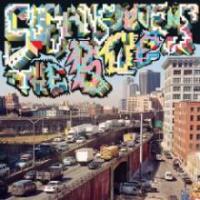Roadmap to Brooklyn's Soul
The indie rocker Sufjan Stevens brings a surprising and delightful buoyancy and sense of wonderment to his orchestral suite commissioned by the Brooklyn Academy of Music to celebrate the 25th anniversary of its “Next Wave” Music Festival. The original debut performances were in November of 2007.
The suite pays tribute of sorts, or at least explores musically, Mr. Stevens' reaction to the clogged and much reviled urban artery known as the Brooklyn Queens Expressway. While the road is now part of the Interstate Highway System (you know, a fantastic achievement brought to you by “the government” that conservatives insist can’t possibly do anything right), it was initially designed to connect the Triborough Bridge (now Robert F. Kennedy Bridge) in Queens with Brooklyn’s Gowanus Parkway.
The late Robert Moses designed the road, which bisected Brooklyn, destroying entire neighborhoods. He did likewise with the Cross-Bronx Expressway. His once shiny star has fallen. The original section of the BQE, and the soon to be replaced Kosciuszko bridge, which spans the once stinky (and perhaps still so) Newtown Creek forms one of the homeliest stretches of road to be found anywhere in the world.
While Sufjan Stevens wasn’t around or old enough to remember, when the original BQE opened, the area below was packed with both working class neighborhoods and a thriving industrial base.
Driving on the BQE back then, one looked out upon smoke belching factories and some that burned bright orange/blue flames of gaseous runoff atop tall, thin rods extending high in the sky. It was a sight.
Among the factories was the original EICO electronics plant where the famed tube amps and kits were designed and built.
There was also the 320,000 square foot Trunz pork products processing plant under the Kosciuszko bridge that emitted some of the foulest smells imaginable, easily distinguished from the car and other fumes.
To this day I can still smell the awfulness coming from that place, even though the closest I ever got was driving on the BQE with my father and sisters to Coney Island and Steeplechase Park. The pork products though, were apparently quite tasty.
All of this smelly, grizzly, ugly history cannot begin to prepare you for the beauty that Mr. Stevens creates here, beginning with a cacophonous drone perhaps meant to resemble traffic on the BQE. That’s followed by a gorgeous, if somewhat pompous fanfare that given the subject matter evokes a twinge of humor behind its grandeur.
Stevens the arranger has always had a deft hand with woodwinds and brass and he uses both here to evoke movement generally and traffic specifically but more subtly than Gershwin did in “An American in Paris,” for instance.
There are strains of Philip Glass’s “Koyaanisqatsi” in the high pitched dancing brass figures and following one of the few genuinely cacophonous outbursts in the piece, a dazzling display of Stevens’ fluffy-light meringue-like woodwind and brass arranging abilities to close out side one.
“Traffic Shock” opens side two with spark showers of a synthesized continuation of side one’s orchestral flow overlaid with woodwinds. Then, it’s back to the syncopated, loping, cascading orchestral figures that wind throughout the sprawling piece. As it heads to a conclusion, the music alternates between splashes of musical graffiti as brass figures explode and drip and passages filled with high drama.
All of that gives way to a lovely celeste interlude followed by more arpeggiated brass and woodwinds and a dazzling finale that does evoke Gershwin, which is surprising since I always thought Sufjan had more Copland in him.
The suite ends with a lovely, introspective solo piano denouement that looks back wistfully at the whole piece, evoking in soft tones, much of the preceding musical action, all of which revolves around hula hoop wielding super heroines and a fanciful science fiction plotline that one needn’t follow to be swept up and taken by the music.
We rarely look forward to rockers dabbling in the classical tradition, whether it’s Paul McCartney who produced some that was pretty good or Billy Joel who said he was going to but didn’t deliver.
Sufjan Stevens’ considerable and more importantly unique orchestrating abilities were obvious on his albums of songs. Here he’s managed to shuck completely the melodic songwriting conventions and constructions to which pop writers normally cling.
Even McCartney’s best “classical” works drifted back toward “tunefulness.” Stevens steers clear of triad based melodic convention here and while the work is evocative in some ways of Philip Glass, what ultimately shines through is the unique Sufjan Stevens musical personality that was remarkably well focused at the beginning of his recording career.
This is a rollicking, dynamic, playful and beautiful piece of music that flows far more effectively than does the BQE. It never gets bogged down in pop music convention and Mr. Stevens’ colorful orchestral arrangements continually delight the rhythmic and harmonic senses, aided by a superbly coherent live studio recording that’s somewhat dry and exquisitely clean and spacious. The LP mastering from a digital source by Ray Janos at Sterling is outstanding and the 180g pressing well-finished and quiet.
The LP packaging is worth a separate review. It’s a triple gatefold full color extravaganza that includes a comic book, an approximately 12”x12” full color glossy booklet containing psychedelicized photos of Brooklyn and the BQE that mirror the comic book’s hula-hoop/Robert Moses/nuclear sub sci-fi story line. Don’t expect an explanation from me! You’ll have to read the comic book and flip through the dazzling photos.
Sufjan Stevens’ BQE is also the soundtrack to a short movie of the same name that I haven’t seen. The vinyl suffices and is most enthusiastically recommended, regardless of your usual musical tastes.
- Log in or register to post comments




